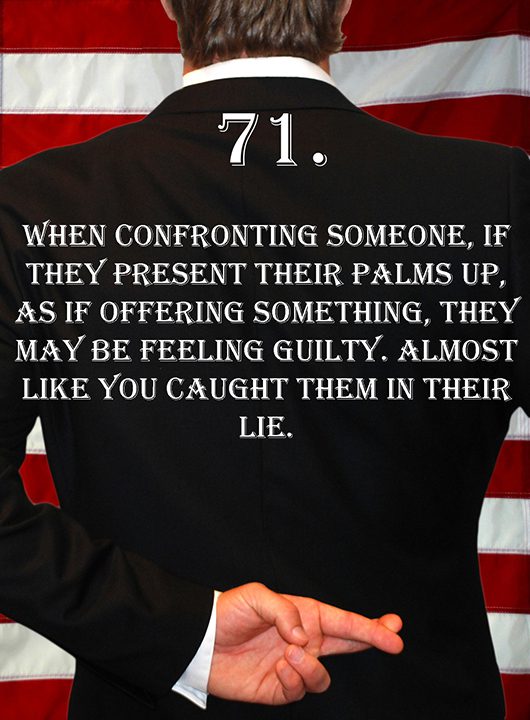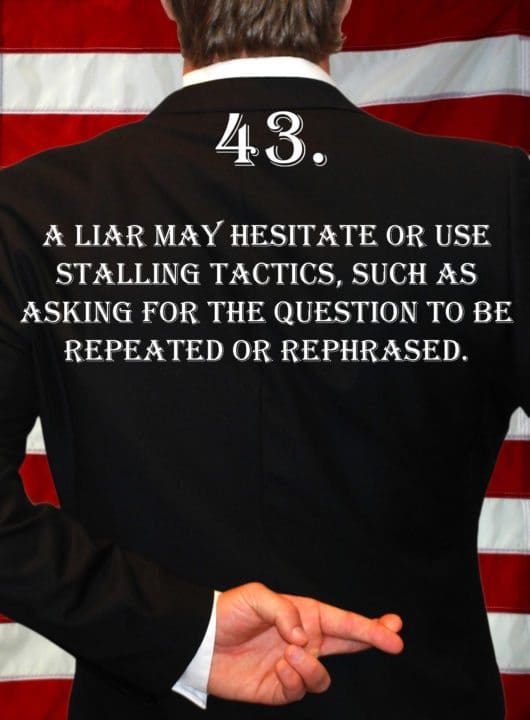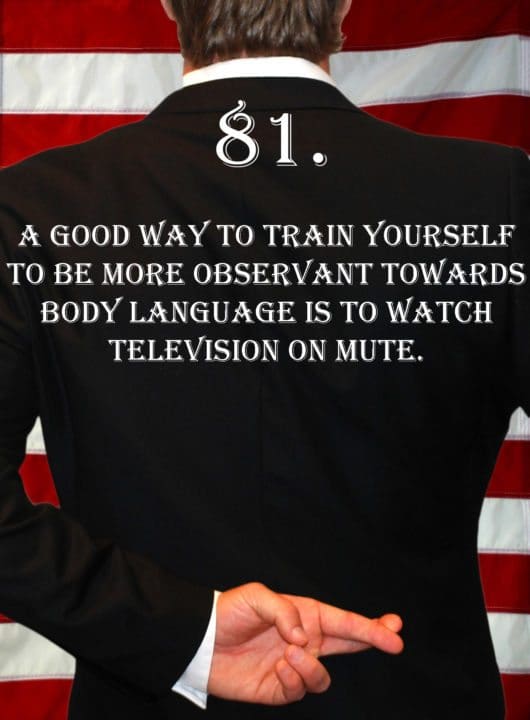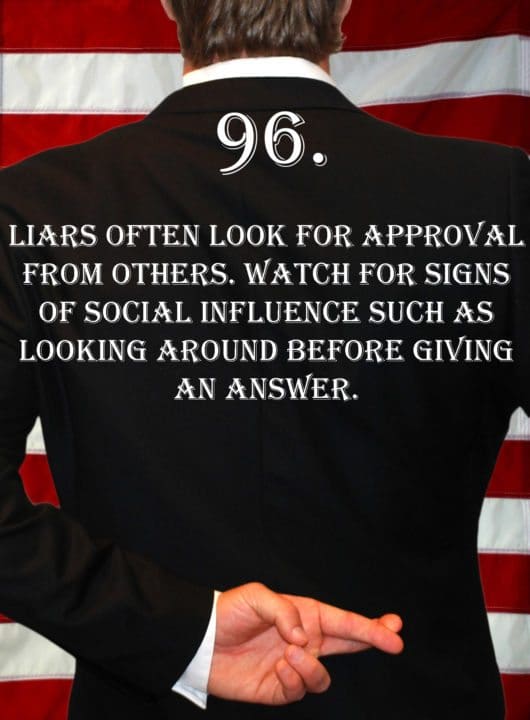
Deception Tip 71:
When confronting someone, if they present their palms up as if offering something they may be feeling guilty. Almost like you caught them in their lie.
Listen To The Podcast!
E71 – Palms Up – Deception Tips Podcast – Click Here To Subscribe
Podcast Transcript
Hello and welcome to the Deception Tips podcast where you will learn amazing cues to detect deceit that will help you read people like never before. I’m your host Spencer Coffman, let’s get started.
Hello and welcome to deception tip episode number 71. Thank you for listening, 71 episodes down, we are making progress, we’ve got a hundred and one in total, so 30 more to go.
That’s 30 more weeks, a little over half a year, you can do it, we can do it, we’ll make it through, you’re going to learn how to read people and detect deception so that you will never be lied to again.
You will be lied to, but you will not be taken advantage of by lies or other people. Therefore, you will be able to see through them and read them and know when someone is lying to you and whether or not they are telling the truth. That is an exciting feeling, learning to know and understand body language is very important, especially in today’s society with all of the lies around you.
Obviously, you know that, or you wouldn’t still be listening, 71 episodes in, this is a huge accomplishment, again, thank you. Today, we have a very special tip in store for you, it’s related to a couple of other tips we’ve had but it’s only related to them. It’s not an identical tip or it’s not something that spins off of it, it’s very, very similar.
Before we get into that, let’s talk about what we spoke of last time. We covered a lot of ground last week, we reviewed several previous deception tips, and we talked about symmetrical and spontaneous expressions. Basically, a truthful, emotional expression, whether it’s a facial expression, a micro-expression, or some kind of body language gesture, any nonverbal communication must be symmetrical, and it must be spontaneous.
In addition, truthful speech also should be spontaneous and symmetrical with the body language that it occurs with, so it’s congruent. We talked about several of those previous tips, anything that happens, so whether it’s speech or gestures, should be simultaneous. It should be symmetrical with the sides of the body and should be congruent with the speech and gestures, which means they should be happening at the same time.
You’re not going to talk and then gesture or gesture and then talk, most people when they say, “Over there” they’re pointing at the same time. Remember the Scarecrow on Wizard of Oz, over there, this way, that away, his hands were moving exactly with his speech. That is how it should be, it should be symmetrical, both sides of the body, if someone is gesturing with their hands they should be gesturing with both hands.
At times you may point in one direction or another, in that case, it will be asymmetrical, but it is still truthful. The main things to watch out for are those gestures that are definitely not symmetrical or that come after the speech, that the timing is off. It’s like that old Godzilla movie where they’re screaming and talking and everything and then all of a sudden, their lips are moving.
Everything is way off, there’s a delay or something happens ahead of something else and then that follows, again, it’s a delay one way or another. Vice versa, it’s either a delay from the gesture after the speech or a delay in the speech after the gesture.
Whenever you see that you know that something is off because it looks off, anytime someone is gesturing and then speaking or speaking and then they gesture it doesn’t gel, it doesn’t match, it’s off.
Therefore, if it’s off it’s not right, so keep that in mind, that if something is not gelling together it’s not Jiving, it doesn’t match, it’s not congruent, it’s not symmetrical. It doesn’t have the same things happening with speech and body language, there are all kinds of craziness going on.
It’s not spontaneous, it looks like they rehearsed it, then you know that there is a big chance that they are not telling the truth, that they are being deceptive.
You don’t know what it’s about yet, but you can poke and prod and see around what area they’re having trouble and then pinpoint it just like a dartboard on the bullseye. You can pinpoint that right in and find out what they are lying about. So, keep that in mind, symmetrical, spontaneous, congruent, all of those things, are good words in body language detection.
Today, we have a different tip, it is, like I said, related to a couple of other tips, we’ll jump into those. It was related to episode 48, slight shoulder shrug where we mentioned how they may give a slight shoulder shrug, I’ll dive into how it is related in a minute. Episode 29, step backward, one of the things that some people may do when they step backward is related to this.
So, here we go, it is deception tip number 71. When confronting someone if they present their palms up as if offering something, they may be feeling guilty almost like you caught them in their lie. Here it is again, deception tip 71. When confronting someone if they present their palms up as if offering something, they may be feeling guilty almost like you caught them in their lie.
So, what does this mean? It means when you are confronting someone as if you are questioning them, you don’t believe what they’re saying. You say to them are you sure because I think this, or this doesn’t match what about this or there seems to be a contradiction here tell me about XYZ. You’re confronting them, you’re calling them out in their lie, they know that you don’t fully believe them, they feel that pressure.
So, if they present their palms up like they’re asking for a handout, almost like they turn them over, their palms are down, their hands may be at their sides, they rotate them over, it’s the beginning of what?
Well, when they turn their palms it’s the beginning of a shoulder shrug, they may shrug their shoulders like, I don’t know, what do you want me to do? What do you want me to say? I don’t know how I can convince you, that kind of thing.
It’s related to a slight shoulder shrug because if you remember it was a one-sided shoulder shrug, but also the palm may turn upward in that as if, “I don’t know.” The slight shoulder shrug is one-sided, so it’s asymmetrical which means deception, remember that.
The other one, stepping backward is related there because sometimes people may raise their hands to ward off the accuser, like hey, hands up, I’m innocent, that type of a deal, so it has a little bit to do with the hands.
In that one, they are putting their palms toward the accuser, showing them their palm just like in this one with the palms moving upward. What does this mean, how does it look in certain situations and what are some more things about it?
How would you see it and why is it indicative of deception or what does it mean when someone does that, why? You’re going to find out a lot more about it coming up right after this.
Do you need to see it to believe it? Would you like to be a more effective communicator? If so, then we’ve got videos for you. Subscribe to the Body Language Channel on YouTube for more deception tips.
Welcome back to deception tip episode number 71. Today, we’re talking about confronting liars and the behavior that they may exhibit when they feel confronted or questioned. This is a behavior of turning their palms upward like they’re presenting an offering or saying, “Hey, my hands are empty, I don’t know.” That is a behavior that shows you they really don’t know what they’re saying.
Keep in mind though that this could be a truthful behavior if it is symmetrical, spontaneous, and simultaneous with their speech, everything is congruent, it all matches up, no problem. Then it could be they really don’t know, they may have been telling the truth, they don’t understand how they were contradicting themselves or what you’re questioning, they don’t know.
In that case, there are two scenarios, number one, they really don’t know, and they were telling the truth and something you saw just didn’t work out. Number two, they might have been lying and they don’t understand your question, they don’t know what you’re questioning them about, so they don’t know how to answer that. That is probably the more likely scenario, so don’t give up yet.
Rephrase your question, put it to them again, or come up with a little bit more specifics to give them to work with because they probably just don’t understand the question. So, what does it look like? Well, it usually looks like, as I said, the beginning of a shoulder shrug.
They’re turning their palms upward and then you generally will see this as a part of a cluster, so they’ll turn their palms then they’re going to shrug their shoulders, and they may step back.
It may even turn into stepping backward and raising their hands to ward off this accusation that you’re putting on them. So, they may turn their palms, lean back, shrug their shoulders, step backward, and raise their hands to say, “Hey, I didn’t do it, it wasn’t me.”
You may see that entire cluster, that whole pattern of behaviors in which case that is several signs. You can be certain something is going on whether they really don’t know or whether they’re pretending to not know is up to you to decide.
If everything is congruent, symmetrical, simultaneous, matches their speech, then you know they really don’t know. So, then it’s those two scenarios, either you misread, or they don’t know what you’re asking, so clarify before you think you misread. The other side of the coin is something that they are lying, and you did catch them in their lie and now they’re stammering and trying to come up with what to say to convince you of the lie.
This is buying them time, they’re warding off this accusation, they can’t believe you would question them, how dare you not trust me, I told you the truth, why aren’t you believing me? They’re going to try to make you feel guilty because they might be feeling guilty themselves.
Usually, when a liar is caught and they have that guilt, their conscious is pushing in, their mind is saying no this is wrong, it’s their moral compass trying to direct them to the right way. They may start feeling guilty, so they’re going to push that guilt onto you in order to relieve their own guilt so that they can get through this lie.
So, that turning upward of palms is a feeling guilty type of a thing where they’re going to feel a little guilty. They may even push it on you saying how dare you not believe me, I came in here on my own goodwill, good faith, I told you my story, whatever the case may be.
They’ll come up with something, they may or may not do that though, so you still need to be vigilant and be looking for other behaviors in what they’re saying, but they may turn their palms upward as you caught them in the lie.
Whatever comes next is very crucial because they will often start speaking, so when you question them when you confront them, let them go through this behavior. Turn the palms up, I don’t know what you want me to say, let them blabber on with filler nonsense for a few seconds, probably 10 to 15 and see what comes next.
Pause, don’t speak, remember the other tips we’ve talked about, how to stay silent, that’s very important. Let them talk because they will continue to speak to fill the gap and they will also speak until they are convinced you do believe them. So, remember that it is important for them to know that you believe them, stay silent was way back in episode 13.
So, keep that in mind because oftentimes a big mistake by the target is that they continue to talk, and they don’t give the liar that chance to talk and trip over their tongue and mess up. When you see this behavior, let the liar speak, become silent was one we talked about a few weeks ago where you need to just become silent and give them that awkward pause to let that tension level go up, that was in episode 69, so remember that.
If you see this behavior, the palms go upward, they may turn it into a shoulder shrug, they may turn it into warding it off, stepping backward, all of this stuff, then let them stammer on, be quiet for a little bit and see what they have to say. If 30 seconds go by and they’re still dumbfounded or deer in the headlights, then you can follow it up. Say hey, this is what I’m asking, what is your response, and then see what they say.
Give them the chance to respond, let that awkward silence be there so that they will feel more and more tense and awkward and stressed, they will eventually give you a response. If in fact, they were lying, chances are they’re going to stammer, they’re going to trip over it. You’re going to see a lot more signs of deception and you will be able to catch them in that lie because you know how to see all of these signs and they are going to exhibit them.
I want to thank you for listening to the Deception Tips podcast. I hope they’ll share it with your friends, subscribe to the feed, take a look at the deception tips videos, the blog, and the books I have available and as always, tune in next week for a new deception tip.
Video Transcript
Hey guys, my name is Spencer Coffman, thank you for watching the deception tips videos. They’re all about teaching you how to read people and detect deception so that you will be able to tell if someone is lying to you. Today we are going to talk about an emotional expression, it’s more of a gesture, this is something that people do when they have no more to offer up.
It’s like they’re out of ideas, maybe they’re out of suggestions, maybe their lie isn’t going very well, and they can’t think of anything else to say or maybe they have exhausted all options. Maybe they’re telling the truth and they don’t know what they can say to convince you but either way, this is something that people do when they feel like they’re tapped out, their options are over. They don’t know what else they can do to either convince you of their lie or convince you of their truth, it is up to you to discern that.
So, here it is, this is Deception Tip number 71. When confronting someone, if they present their palms up as if offering something, they may be feeling guilty. Almost like you caught them in their lie. This is important as well because it’s something like when you’ve caught them in their lie, they may be feeling guilty.
Palms up, so are they one palm, two palms, how is it going? Remember in Deception Tip 29 we talked about the stepping backwards with their hands up as if they’re warding off the accusation that someone is throwing at them. That hands up is kind of an innocence gesture like when the cops come in or they’re going to raid and all the innocent people in a school shooting or something like that, they’re running out of the building with their hands up.
Why do we put our hands up? It’s to show people that we don’t have anything, we’re not a threat. So, part of that in episode 29 when we talked about that was they’re putting their hands up, they’re stepping back saying I’m not a threat to this, I’m warding off this accusation of you accusing me of lying.
In today’s episode, we’re talking about how they may be presenting palms up, not like this although it could be but more like this as if offering something. Like saying, “I don’t have anything more to give” or they’re feeling guilty maybe because they don’t have anything more to give and they told you the truth. So, it’s a double-edged sword on this one but remember to look for the patterns and the clusters of behavior that go along with it.
Those will be able to tell you whether or not they are telling the truth and they don’t know what to say or if they’re lying to you and they don’t know what to say in order to convince you of the rest of their lie. Another thing too is that these palms up gestures could go with the shoulder shrugging. If someone is shrugging their shoulders like maybe you ask them “Hey, where did XYZ happen” and they, “I don’t know”, well they don’t have any more to give.
They’ve shrugged their shoulders, they put their palms up, that was a symmetrical expression, it was spontaneous, it went all together, it wasn’t, “I don’t know” and it didn’t line up. So, keep watching for those because when people present their palms, remember the old movies of ‘Alms for the Poor’, they want something in their hand. Either they want you to provide something or they don’t have anything to give.
That’s what you need to remember when you see these types of gestures whether it’s the palms this way or this way. Anytime someone is giving you their palm they are saying that they’re not a threat, they don’t have anything else to give you, they don’t know what to say, they may not have confidence in what they’re saying. Remember, if it’s a one-sided type shoulder shrug with a palm just keep that in mind whenever you see the palms go that the person is having an internal conflict of, they don’t know.
Something is going on that they aren’t certain of, they either don’t have confidence in it, they don’t want to stand behind it, they’re ashamed of it or bashful about it, something is going on there that they are not 100% convinced of. People that are convinced or that know what they’re saying are going to have a lot more powerful and strong body language that goes with what they’re speaking about. So, keep an eye out for these gestures because a lot of times when someone is telling a story, if they don’t show any confidence in that story it could be due to deception.
So, if this is your first time watching these videos, I’d love to have you subscribe to the channel on YouTube. Feel free to comment with any questions you may have as well. Also, if you’d like some more information, we’ve got books, blog posts, podcasts, all available on spencercoffman.com that are dedicated to teaching you exactly what every body is really saying.
Until next time.




